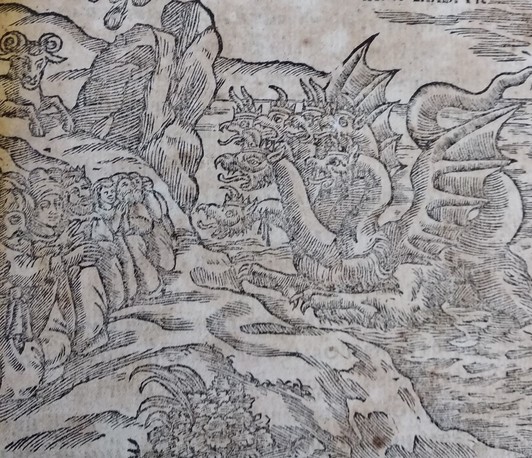The Web of Images
Research Seminar
- Public event without registration
- Date: Jun 3, 2024
- Time: 11:00 AM - 12:30 PM (Local Time Germany)
- Speakers: Piotr Ł. Grotowski, Olena Derevska
- Location: Villino Stroganoff, Via Gregoriana 22, 00187 Rome and online
- Contact: mara.freiberg@biblhertz.it

This research seminar is the third in the series of events “The Politics of Images” that will cover several aspects of the imagery’s circulation in, but not limited to, Ukraine. We seek the parallels within and beyond the former Soviet space that would help to have a better comprehension of the images’ social power and dispositifs. Organized within the ScienceForUkraine programme.
Piotr Ł. Grotowski. Orthodox Art in the Service of the first Jagiellons: Politic, Society and War (11.00-11.45)Focusing on political peripeteia and complex dynastic relations in the late medieval and early modern Polish-Lithuanian Commonwealth, Piotr Grotowski will simultaneously present monumental art as part of the state policy of the first rulers of the Jagiellonian dynasty.Polish king Ladislaus (Jogaila) had to prove that despite his pagan origin he was not a barbarian and that he was worthy of esteem from his subjects.As a way to underline his Christian roots, he chose Orthodox frescoes commissions executed in the interiors of his palaces and Latin churches. Initially, he employed mostly Ruthenian masters from Przemyśl and Drohobych surrounding (that is from Red Ruthenia incorporated already by Casimir the Great), but with time also artists from more remote areas, such as Kyiv and northern borders of Lithuania. Especially interesting are frescoes in Sandomierz Collegiate church (executed between 1402 and 1416), Zawichost church and Trakai parish church (1409) painted by Serbian painters, who came probably with further Kievan Metropolitan, Gregory Tsamblak.To the tradition of Eastern decorations in Gothic churches returned Ladislau's second son, Casimir the Jagiellon. In 1470 he ordered frescoes in his burial chapel at Wawel Cathedral in Cracow. The commission was completed by northern masters from Pskov or Novgorod, whom he invited during his visitation of eastern strongholds in the spring of the same year. The inspection was arranged due to the offer of the Novgorod Republic, which was endangered by Muscovite expansion sought support in the Polish-Lithuanian kingdom offering Casimir Grand Prince throne. While scholars generally accept the northern source of the Holy Cross Chapel frescoes, closer analysis reveals also traces of local school influences. Ruthenian icons from Zwierzyń Elevation of the Holy Cross monastery preserved in the Museums in Kyiv and Lviv present very similar solutions in iconography and costume details, which attest participation of local masters in this last Jagiellon's commission.
Olena Derevska. Reformation iconography and visual propaganda in Ukrainian art of the 17th – 18th centuries (11.45-12.30)
The introduction of the Reformation iconography into Ukrainian art of the 17th and 18th centuries resulted in the development of new religious imagery plots. The Apocalypse theme could be seen in Ukrainian art since the 11th century, as the part of Last Judgement plots. Reformation imagery series, following the Luther Bible editions and numerous German woodcuts, later copied or creatively reshaped all over Europe, reached Ukraine likely at the end of the 16th century and have been used and transformed from the early 17th century. Starting from Master Prokopii’s series of Apocalypse (1646-1662), issued in Kyiv Pechersk Lavra, Ukrainian artists, mostly Orthodox monks, have used not only the plots but also Lutheran visual forms of religious propaganda. First anti-Catholic, depicting Pope as Antichrist, images later started to omit Roman Catholics in condemnation, as part of Ukrainian Orthodox eparchies in the Western Ukraine who hadn’t converted to Creek Catholicism previously began to discuss Union with Rome. By the end of the 17th century and later at the beginning of the 18th century, the Ottoman threat had become the main theme of such propaganda, which is clearly seen in the 1717 Chernihiv woodcut series of Apocalypse designed mostly by Nikodem Zubrzycki.The ongoing research has several difficulties. Postcolonial practices of art history in Ukraine tended not to study closely the cultural convergence of the territories of the Polish–Lithuanian Commonwealth. Another problem was showing Ukrainian art as a part of Russian. One more issue to work over is the previous mostly mono-confessional Orthodox paradigm of art studies. Religious and literary sources that could have influenced Ukrainian art, both Eastern and Western, need further studying as well. Digitalization of Ukrainian cultural heritage which in fact has just been under way is also of crucial necessity.
This event can be followed also ONLINE on our VIMEO CHANNEL: https://vimeo.com/event/4352471
Scientific Organization: Alina
Kondratiuk
Image:Nikodem Zubrzycki. Seven-headed Beast from the sea. Illustration from Revelation 13. New Testament, 1717, Chernihiv. Vernadsky National Library of Ukraine, Kyr. 476. Courtesy Olena Derevska All rights reserved.